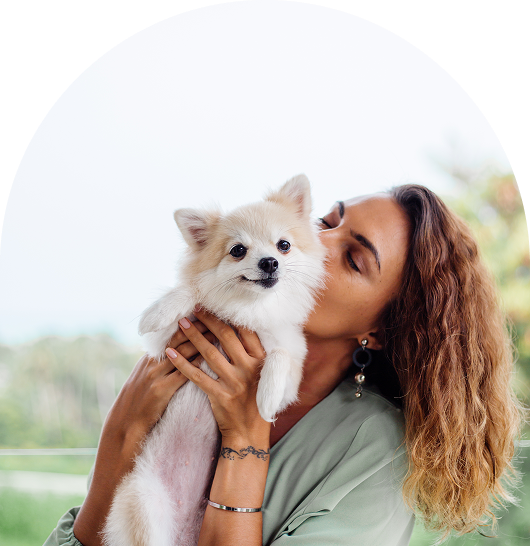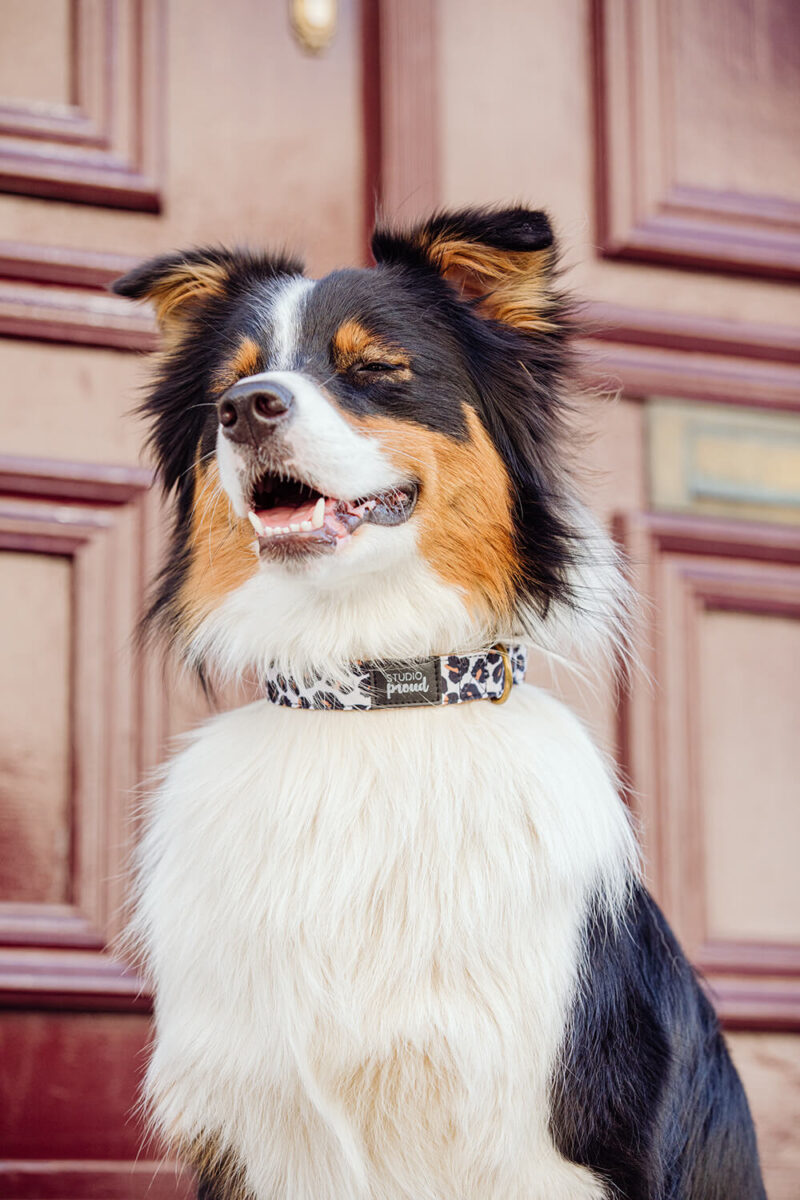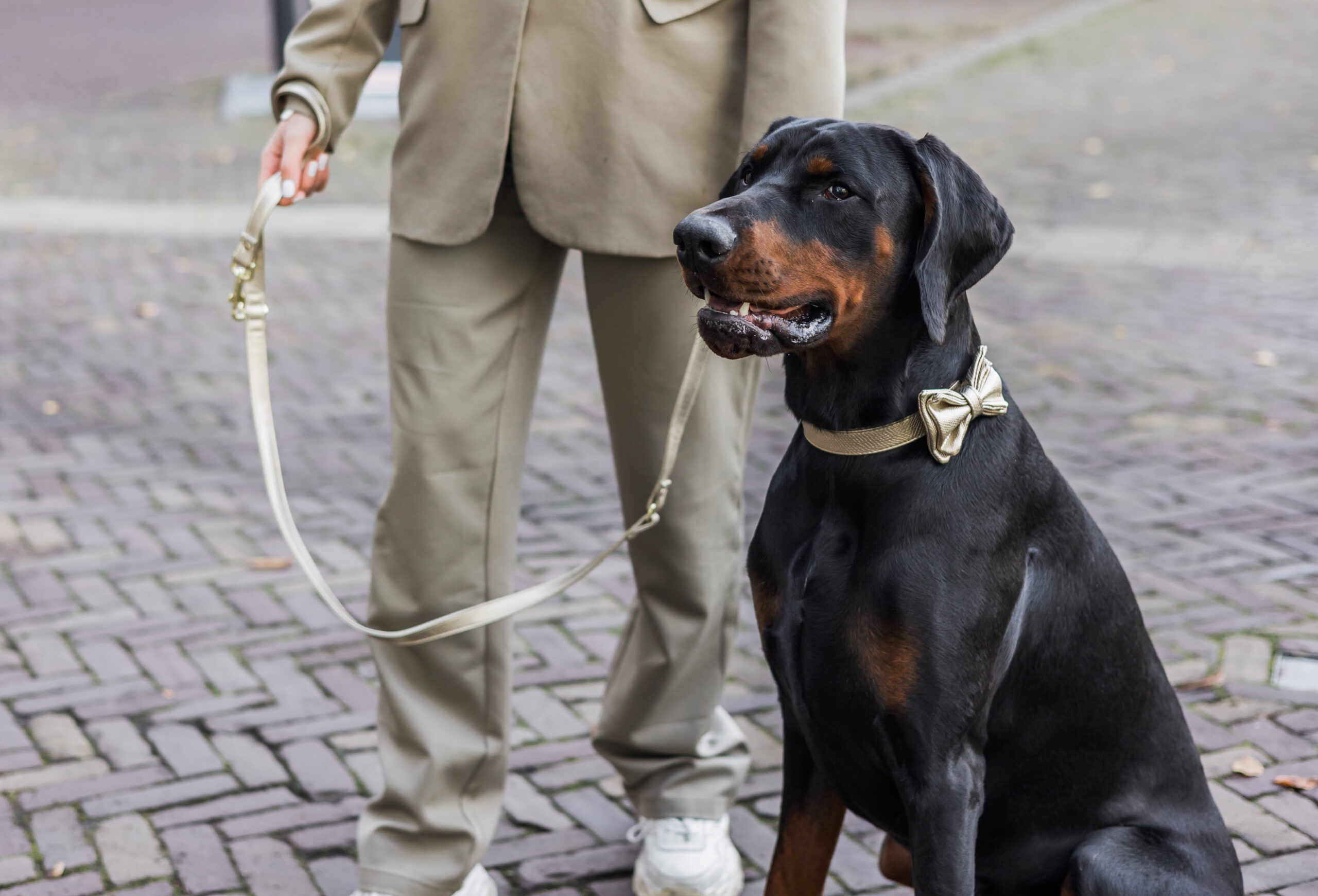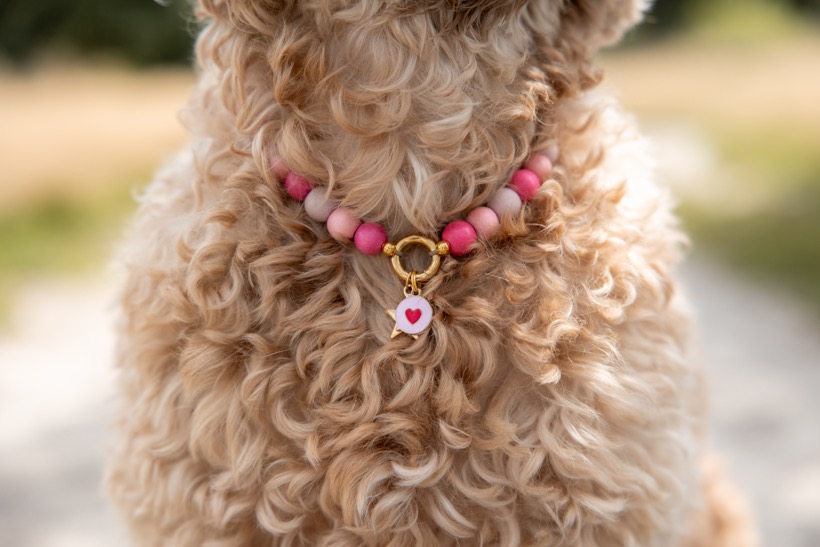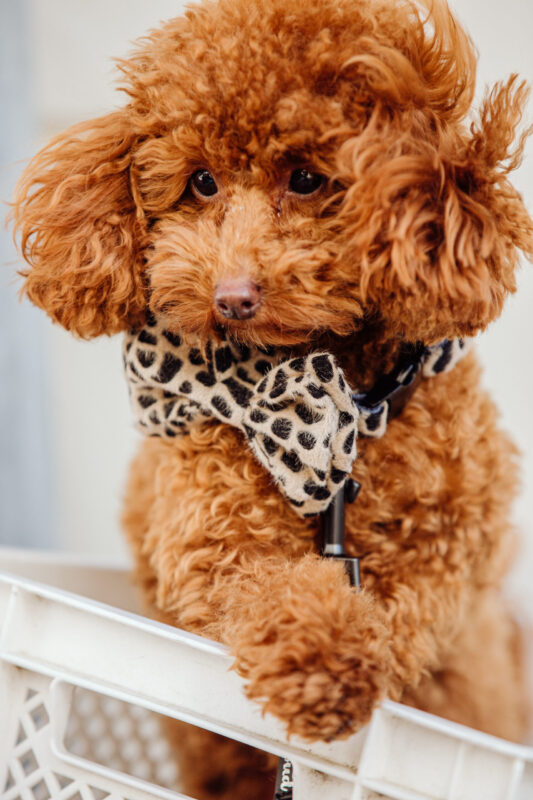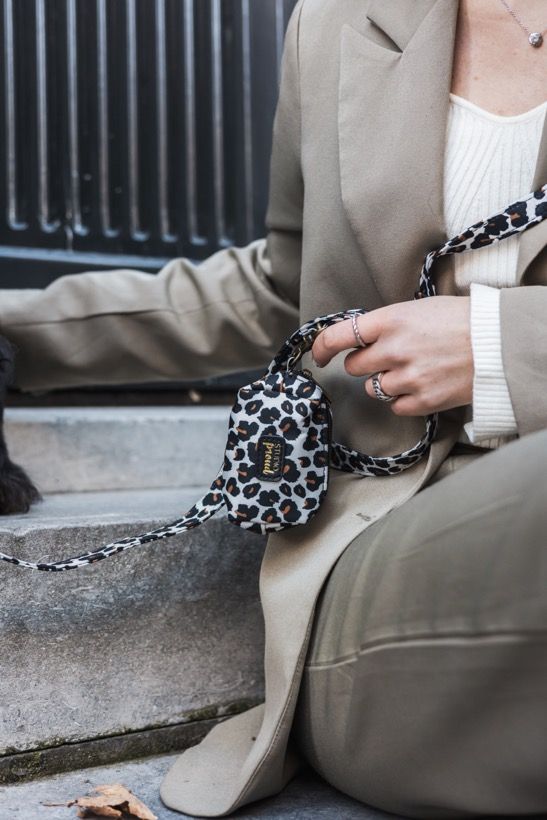FAQ hondenvoer
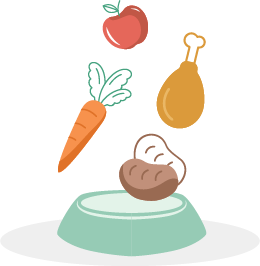
Ingrediënten/samenstelling
-
Wanneer kies ik voor een geperste of krokante brok?
Klantenservice Eddie: “Wij hebben beide type brokken, uit de kieswijzer volgt komen welke van de twee het beste past bij jouw hond”.
Onze dierenarts Anne: “Het verschil tussen een geperste brok en een krokante brok zit in de manier van bereiden. Beide type brokken worden onder verschillende temperaturen verwerkt. De kwaliteit van de ingrediënten is gewaarborgd, maar door de bereidingswijze zit er een verschil in de structuur”. Lees meer over het verschil tussen deze brokken en de manier van produceren in onze blogpost.
-
Is het voer natuurlijk?
Onze dierenarts Anne: “Alle voedingen van Studio Proud wordt gemaakt van natuurlijke voedingsstoffen. Er zijn geen chemische toevoegingen! Ook geen geur – , kleur – en smaakstoffen toegevoegd, dat maakt deze brok gezond en verantwoord”.
-
Mijn hond is allergisch voor graan, hebben jullie ook een voeding die graanvrij is?
Klantenservice Eddie: “Zeker hebben wij graanvrije brokken! Doe hiervoor de kieswijzer.”
-
Welk voer is het meest gezond?
Onze dierenarts Anne: “Het belangrijkst bij het kiezen van de juiste voeding voor je hond is dat je hond het er goed op doet. Daarom is er niet één juist antwoord op deze vraag. Een goed voedingsadvies is altijd afgestemd op de individuele hond. Daarom heeft Studio Proud de kieswijzer ontwikkeld, zodat je uitkomt bij de meest geschikte voeding voor jouw maatje!”
-
Waar komt het voer vandaan?
Klantenservice Eddie: “Het voer wordt lokaal geproduceerd! Het hoeft dus geen kilometers te land, ter zee of via de lucht vervoerd worden. Wij vinden duurzaamheid belangrijk en willen voorkomen dat er onnodig te grote afstanden worden afgelegd voordat de brok bij jullie thuis is!”
-
Zitten er smaak- , geur- en kleurstoffen in het hondenvoer?
Klantenservice Eddie: “Onze brokken zijn gemaakt van natuurlijke grondstoffen en bevatten geen kunstmatige kleur-, geur- en smaakstoffen.”
-
Komt het eiwit-gehalte uit dierlijke producten?
Onze dierenarts Anne: “Onze voeding wordt gemaakt van de meest hoogwaardige ingrediënten. Wij hebben de keuze gemaakt om alleen brokken in ons assortiment op te nemen waarvan het grootste deel van het eiwit-gehalte bestaat uit dierlijk eiwit, m.u.v. de vegetarische variant”.
-
lk zie vaak vers vlees, hebben jullie dat ook?
Onze dierenarts Anne: “Er bestaan geen brokken die gemaakt worden van vers vlees, want het feit dat het vlees verwerkt is tot brok maakt dat dit niet meer valt onder de noemer vers vlees. De keuze om (vers) vlees of brokken aan je hond te voeren is heel persoonlijke. Vlees voeren is vaak wat ingewikkelder en vergt een hoge hygiënische standaard. Wij kiezen er daarom voor om alleen brokken aan te bieden, zodat we zeker weten dat je hond een complete voeding krijgt en niet bijgevoerd hoeft te worden. Een groot voordeel van brokken is daarnaast dat het de tanden schuurt en daarmee vertraagd het de vorming van tandplak en het ontstaan van tandsteen!”
-
Hoeveel procent eiwit heeft mijn hond nodig?
Onze dierenarts Anne: “De gehaltes aan eiwit die een hond nodig heeft zijn zeer afhankelijk van de mate van beweging. Zoals bij mensen ook zo is, heeft een sporthond meer eiwit nodig in zijn dieet voor de opbouw van spieren. Een hond die wat minder actief is, heeft dit niet nodig. Voor een gemiddelde huishond die regelmatig een stuk loopt, is een eiwitgehalte van ongeveer (X% hoeveelheid in de brok die we verkopen) voldoende. Voor de actieve honden zou je dan kunnen kiezen voor een brok uit de active lijn, met eiwitgehaltes van XX-XX%
-
Hoe lees ik de ingredienten lijst?
Onze dierenarts Anne: “Een ingrediëntenlijst is altijd compleet, dit is wettelijk verplicht. Alle ingrediënten zitten in de voeding, waarvan het eerstgenoemde ingrediënten het hoofdbestanddelen is en naarmate het ingrediënt lager staat in de lijst, zit hiervan minder in de voeding. Je kunt er echter vanuit gaan dat wij alleen zeer evenwichtig samengestelde voeding verkopen! Daarom hoef je hier zelf niet meer te gaan puzzelen.”
-
Zijn jullie brokken een complete maaltijd of moet ik mijn hond extra bijvoeren met ander voer?
Onze dierenarts Anne: “Al onze voedingen is evenwichtig en compleet en voorziet je geliefde huisdier van alle voedingsstoffen die hij/zij nodig heeft voor een gezond en gelukkig leven. Natuurlijk is het altijd fijn om ze af en toe een lekker hondenkoekje of kluifje te geven. Dit kan, met mate, geen kwaad.”
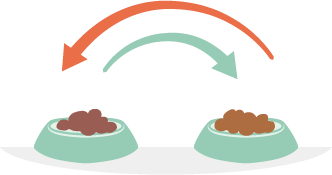
Wisselen van voer
-
lk ben tevreden over mijn huidige voer, waarom zou ik wisselen?
Onze dierenarts Anne: “Soms kan het wisselen van voer juist goed zijn, om te zorgen dat je hond het bijvoorbeeld weer enthousiaster gaat eten of om toch een wisseling in bronnen van voedingsstoffen te krijgen. Te vaak wisselen is niet goed, maar af en toe een andere soort of smaak brok kan de gezondheid van je hond bevorderen!”. Lees meer over het wisselen van voer in onze blogpost.
-
Kan ik zomaar wisselen van voer?
Onze dierenarts Anne: “Het wisselen van voer moet geleidelijk gebeuren, zodat het maagdarmstelsel van je hond langzaam kan wennen aan de nieuwe brokken. Hoe je dit het beste kunt doen en hoe je kunt switchen van bijvoorbeeld een krokante naar een geperste brok, kun je lezen in onze blogpost.”
-
Mij is verteld dat het niet goed is te wisselen van voer, klopt dat?
Onze dierenarts Anne: “Net zoals bij zoveel dingen in het leven, is teveel niet goed. Te vaak wisselen, te snel wisselen, dat kan allemaal leiden tot klachten aan het maagdarmstelsel van je hond. Af en toe wisselen, of het wisselen van voer wanneer je graag over wilt stappen op een andere brok, is echter geen probleem! Doe hiervoor de kieswijzer, om te zien welke brok het beste bij jou en je hond past en lees onze blogpost voor meer informatie over het wisselen van voeding!
-
Wanneer is het niet goed om van voer te wisselen?
Onze dierenarts Anne: “Wanneer je hond door de dierenarts op een specifieke voeding is gezet, of wanneer je door lichamelijke of gezondheidsklachten voor een speciale voeding hebt gekozen, is het af te raden om zomaar van voeding te wisselen. In dit soort gevallen geven wij graag gepast advies, of verwijzen wij je door naar je eigen dierenarts.” lees meer over het wisselen van voer in onze blogpost
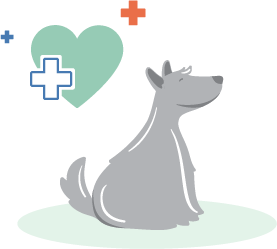
Gezondheid hond
-
Klopt het dat ik voor mijn rashond ook speciaal rasvoer nodig heb?
Onze dierenarts Anne: “We weten van sommige rashonden dat deze gevoelig kunnen zijn voor bepaalde afwijkingen en ziektes. Wanneer je hond bij een verantwoorde fokker vandaan komt, zal er bij de ouder dieren gekeken zijn in welke mate deze aandoeningen voorkomen. Het is echter niet nodig om specifieke voeding voor jouw rashond te kopen. Onze voedingen zijn geschikt voor alle type hondenrassen, mits er geen onderliggende gezondheidskwalen zijn natuurlijk. Indien jouw hond klachten heeft, ga hiervoor dan altijd naar je dierenarts”. Wij verwijzen je hiervoor naar Achtergrondinformatie: Keuringsdienst van Waarde | Hondenrasvoer
-
Waar moet ik op letten bij hondenvoer?
Onze dierenarts Anne: “Het belangrijkste is dat je voeding kiest die past bij jouw hond en jullie levensstijl. Onze kieswijzer kan je helpen hierbij helpen. Wanneer je vragen hebt over bijvoorbeeld het wisselen van type of soort voer, vind je hier meer over in onze blogpost”.
-
Hoe belangrijk is goede voeding?
Onze dierenarts Anne: :”Goede voeding is essentieel voor een gezond en gelukkig leven van je hond! Het houdt je dier gezond en ondersteund bij gezondheidsklachten. Goede voeding is van levensbelang!”
-
Waarom is er onderscheid tussen voer voor puppies, grote honden, volwassen en actieve honden?
Onze dierenarts Anne: “Je kunt je voorstellen dat verschillende levensfases en levensstijlen vragen om verschillende voeding. Puppies moeten groeien en hebben een klein maagje, waardoor puppy-voeding een hoog gehalte aan essentiële voedingsstoffen heeft en relatief veel calorieën per gram voer. Bij grote honden zijn vooral de verhoudingen van de voedingsstoffen van belang en dan specifiek de gehaltes aan calcium en fosfaat, in verband met de botgroei. Actieve honden gebruiken dagelijks meer energie, waardoor zij voeding nodig hebben met extra calorieën en eiwitten. Hierdoor hebben wij een specifieke voeding samengesteld zodat deze honden voldoende voedingsstoffen binnen krijgen en niet bijgevoerd hoeven worden.”
-
Hoeveel voer heeft mijn hond nodig?
Klantenservice Eddie:” Op elke verpakking staat een indicatie van de hoeveelheid voer aangeraden wordt bij het gewicht van jouw hond. Bij onze producten vind je een advieswijzer.”
Onze dierenarts Anne: “Het is belangrijk om te kijken naar de conditie van je hond, door ons ook wel de Body Condition Score (BCS) genoemd. Bij een gezonde hond, met een gezond gewicht, moet je de ribben zonder al te veel druk op de borstkas kunnen voelen en tellen en is er een taille te zien.”
-
Hoe weet ik de conditie van mijn hond?
Onze dierenarts Anne: “De conditie van je hond is te zien in de Body Condition Score (BCS) tabel, zie hier. Bij een gezonde hond met een gezond gewicht, voel je de ribben en kun je deze tellen zonder druk op de borstkas uit te oefenen. Een gezonde hond heeft daarnaast een taille.”
-
Is mijn hond allergisch?
Onze dierenarts Anne: “Wanneer je twijfelt of je hond ziek is of een allergie heeft, raad ik altijd aan om naar een dierenarts te gaan. Bij een hond met een voedingsallergie zien we vaak verschillende symptomen. Alleen zouden deze symptomen ook kunnen passen bij andere ziektes. Bij twijfel is het dus altijd verstandig je dierenarts om advies te vragen!”
-
Hoe weet ik of mijn hond allergisch is? Hoe signaleer ik verschillende symptomen?
Onze dierenarts Anne: “Een hond met een voedingsallergie zal vooral regelmatig jeuk hebben. Dit kun je zien doordat de hond bijvoorbeeld overmatig aan zijn voetzooltjes likt, in zijn liezen en/of oksels krapt/bijt en een rode huid krijgt. Daarnaast kan het ook zijn dat je hond last heeft van terugkerende oorontstekingen, of wisselende maag-darm klachten. Je ziet dus dat er veel verschillende symptomen kunnen passen bij een allergie! Bij twijfel raad ik daarom altijd aan om naar je dierenarts te gaan.”
-
Wat zijn de kenmerken van een gezonde hond?
Onze dierenarts Anne: “Een gezonde hond zit lekker in zijn vel. Afhankelijk van de leeftijd, het ras en levensstijl, wil een gezonde hond graag wandelen, spelen en knuffelen. Een gezonde hond heeft een mooie glanzende vacht. Een goede conditie en is niet te dik of te dun. De ontlasting is mooi stevig en het kost ze niet veel moeite om deze kwijt te raken.”

Blogpost krokant/geperst
-
De geperste brok
Geperste hondenbrokken zijn compact en geconcentreerd. Alle voedingsstoffen worden bij elkaar geperst zonder dat er lucht in de brokken komt. Deze hondenbrokken nemen zowel in de verpakking als in de maag minder ruimte in. Je hoeft dus ook minder te voeren! Geperste hondenbrokken vallen in de maag uiteen. Hierdoor is de maagbelasting minder groot en is de geperste brok ideaal voor actieve honden. Productie geperste brokken: Bij de bereiding van krokante brokken wordt een mengsel van grondstoffen bij 75°C door de matrijs (vormplaat) geperst. De relatief lage temperatuur zorgt voor een minimale belasting van grondstoffen.
-
De krokante brok
Krokante hondenbrokken worden geëxtrudeerd. Geëxtrudeerde brokken zetten uit in de maag en zijn licht verteerbaar. De krokante brokken zijn harder waardoor honden er extra goed op moeten kauwen. Wat is extruderen? Door te extruderen worden granen gegaard en ontsloten. Dit gebeurt bij een temperatuur van maar liefst boven de 130°C! Wanneer het mengsel uit de extruder komt valt de druk weg, de brok wordt hierdoor opgeblazen en lekker krokant.
Schrijf je in en ontvang 10% korting
Blijf op de hoogte van de nieuwste collecties, exclusieve acties en tips voor jouw hond. En ontvang direct 10% welkomstkorting.
